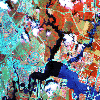GEOL 5631 - Spring 2023 (Fully Face to Face Class) Outline of Class Schedule |
Title: Remote Sensing: Applications in Earth Science |
|
Instructor:
Dr. David E. Pitts Faculty Office: Bayou 3-531 Phone:281-283-3770 Fax: 281-283-3709 Webpage: http://sce.uhcl.edu/Pitts/ E-mail: |
| Classroom: STEM 2105 Tuesday evening 7 pm to 9:50 pm |
| Office Hours: The hour before class and the hour following class. |
| Textbook: Introduction to Remote Sensing, 6th ed., 2022, James B. Campbell, Randolph H. Wynne, and Valerie A. Thomas, Guilford Press, ISBN 9781462549405 hard cover. |
| Prerequisites: GEOL 3034, 4222, 4234 or equivalent. |
| DESCRIPTION: Emphasizes applications of remote sensing to geology, hydrology, oceanography, forestry, agriculture, and land use. Computer laboratory exercises are included using Freeware. |
| Objective:To provide the student with a working knowledge of spacecraft and aircraft remote sensing imaging systems and techniques for extracting Earth science information from remotely acquired data. |
|
Methodology:1. Face to Face Lectures on new concepts. |
|
Appraisal:Homework 10% |
|
Honesty Code:The Honesty Code is the university community's standard of honesty and is endorsed by all members of the University of Houston-Clear Lake academic community. It is an essential element of the University's academic credibility. It states: |
|
January 24 (Week 2) Basic concepts of Remote Sensing , Chapter 2 Electromagnetic Radiation, Energy from the Sun and Interior of the Earth, Color Demonstration, Assign homework 1 January 31 (Week 3) Photo Systems (Chapter 4), Image Interpretation (Chapter 6), Review a high altitude image of Lubbock Texas, Homework 1 due Feb 7 (Week 4) Digital Imagery (Chapter 5), Land Observations Satellites (Chapter 7), Sun Synchronous and Geosynchronous satellite orbits Feb 14 (Week 5) Tutorial using Multispec, Clustering and Supervised Classification. Review an image of the Amazon. Study questions for Exam #1 Feb 21 (Week 6) Exam # 1 (Chapters 1 thru 7) Feb 28 (Week 7) Thermal Radiation Sensing, Chapter 10, Tutorial on Images of Houston, Paragraph describing research paper is due.. March 7 (Week 8) Active Microwave Sensing, Chapter 8, Lidar Chapter 9, Tutorial on finding the best channels March 14 (Week 9) Spring break March 21 (Week 10) Image Resolution (no chapter), Statistics & Preprocessing Chapter 11, Derivation of Important Formulas, Tutorial on how to open a raw image, Compare Ikonos Satellite image with Indian IRS-1 satellite image. March 28 (Week 11) Image Classification Chapter 12, Field Data Chapter (no chapter), Change Detection Chapter 15, Principal Components Tutorial. Second Exam (take home exam covering Chapters 8 thru 12). April 4 (Week 12) Accuracy Assessment Chapter 13, Tutorial on Merging bands, Assign homework 2 April 11 Last Day to Drop. April 11 (Week 13) Hyperspectral Remote Sensing, Chapter 14 , Earth Sciences Chapter 19, Tutorial on using ratios of bands to detect minerals, Homework 2 due. April 18 (Week 14) Plant Sciences Chapter 16, Agriculture (Chapter 17), Forest (Chapter 18). Calculation of Solar Zenith and Azimuth angles. April 25 (Week 15) Coastal Processes Chapter 20, Land Use Chapter 21, Geographic Information Systems (no chapter in book). May 2 (Week 16) Present your research paper to the class and submit your research paper. |
| GRADING
SCALE (%) MINUS NO
SIGN PLUS |
Remote Sensing
Remote Sensing
Home | Geoscience | Image Processing | Remote Sensing Natural Disasters | ©2022-2023 David E. Pitts

